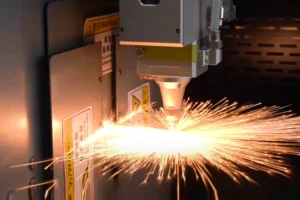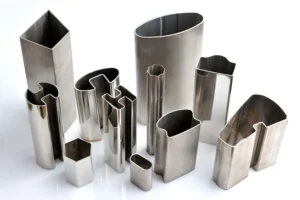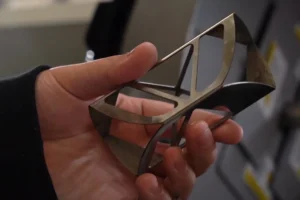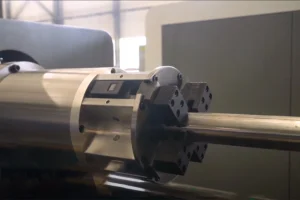Tube laser cutting is a key technology in the rapidly developing manufacturing industry. It can process a variety of metal tubes with high precision and efficiency. This blog post delves into the ten most common questions about laser tube cutting. This comprehensive overview will provide you with the professional knowledge to help you make the right choice.
1. What is Tube Laser Cutting?
- Function: The laser tube cutting machine has high-precision, automated tube cutting capabilities, supports cutting of a variety of metal materials and complex graphics, and significantly improves production efficiency.
- Features: Its characteristics are high precision, high efficiency, environmental protection and energy saving, and it adopts a non-contact cutting method to avoid physical damage, with excellent cutting surface quality and low long-term maintenance costs.
- Principle: The laser cutting tube uses the high-energy-density laser beam to focus and generate high-temperature melting and vaporization of the tube material, and achieves fast and accurate cutting through precise control.
2. What Materials Can Tube Laser Cutting Cut?
- Steel: Mild steel and stainless steel are both commonly cut with tube lasers. The technology is well suited to handling materials of varying thicknesses. It allows for precise cuts with clean edges.
- Aluminum: Although aluminum is more reflective than steel, it can still be cut with a fiber laser. Tubular laser cutting of aluminum requires careful change of power and speed for optimal results.
- Copper: Like aluminum, copper is a highly reflective material. Fiber lasers can handle copper cutting by operating at wavelengths that the material absorbs more efficiently.
- Brass: Brass is another material that can be cut with a tube laser. The reflective and thermally conductive properties of brass are well managed with fiber lasers.
- Titanium: Titanium is known for its strength and lightweight properties and is commonly used in the aerospace and biomedical industries. It can be precisely cut with a tube laser.
- Other Materials: Also to the metals mentioned before, tube laser cutting can be used on a wider range of metals. Examples include nickel alloys, chrome alloys, galvanized steel, tool steel, coated metals, etc.
3. Can Tube Laser Cutting Cut at Angles?
Tube laser cutting is able to cut at various angles. Including but not limited to the common 30°, 45°, 90° and other angles, it can also cut at any angle according to the needs. This is due to the high flexibility and advanced control system of the laser cutting machine. They can accurately adjust the position and angle of the cutting head to meet the cutting needs of different shapes and angles. In actual operation, factors such as the physical properties of the material, the limitations of the machine, and the cutting efficiency must also be considered to ensure the accuracy and stability of the cutting.
4. How Long and Wide Can Tube Laser Cutting Cut?
The cutting capacity of a pipe laser cutter depends on the specific model and manufacturer specifications. Yet, I can provide some general guidelines and typical capacities that you may encounter in the industry.
4.1 Length Capabilities
Standard Machines: Standard machines are equipped to handle tubes from 6 meters to 12 meters (about 20 feet to 40 feet) in length. This range is suitable for most industrial applications, including construction, automotive, and manufacturing.
Extended Length Machines: Some machines are designed to handle longer tubes. These specialized machines are less common, but can be obtained through customization.
4.2 Diameter Capabilities
Small to Medium Diameters: CNC laser tube cutting machine can handle diameters that are typically about 0.5 inches (12.7 mm) to 12 inches (304.8 mm). This range is suitable for a variety of applications from complex components to larger structural parts.
Large Diameter Machines: Some machines are capable of handling larger diameters, up to 24 inches (610 mm) or larger. Such machines are designed for industries such as pipe fabrication or large structures.
4.3 Wall Thickness
Material Dependent: The greatest wall thickness that can be effectively cut also depends on the material being cut. For example, a machine can cut stainless steel up to 10 mm thick or mild steel up to 20 mm thick. Specific capabilities may vary depending on laser power and machine design.
4.4 Machine Features That Affect Cut Size
Laser Power: Higher-powered lasers can more effectively handle thicker, larger diameter tubes.
Chuck and Support System Design: The way the tube is secured and rotated in the tube laser machine can also limit or expand the greatest size that can be handled. Machines with more powerful support systems can handle heavier, larger diameter tubes.
5.What Shapes of Tubes Can Laser Tube Cutting Machines Cut?
Tube laser cutting machines can cut a wide variety of tube shapes with high precision and efficiency. Here are the main shapes that these machines can cut, summarized clearly and structured:
5.1. Circular Tubes
Capabilities: Laser tube cutting machines can effortlessly cut circular tubes. Including round steel tubes, aluminum tubes, and stainless steel tubes.
Accuracy: The cutting process involves rotating the tube while simultaneously applying the laser beam, ensuring precise and flawless cuts.
Applications: Widely used in industries such as automotive, shipbuilding, and plane manufacturing.
5.2. Rectangular/Square Tubes
Capabilities: These machines can also cut rectangular and square tubes. Including square steel tubes, rectangular steel tubes, and angle steel tubes.
Precision: High precision, high flatness, and smooth cutting surfaces are achieved, making them suitable for complex graphic cutting.
Applications: Commonly used in construction, engineering, and furniture industries.
5.3. Triangular Tubes
Capabilities: Laser tubing cutter can cut triangular tubes, which are often required for specialized applications.
Methods: Typically cut using fixed-angle cutting modes, ensuring accurate results.
Applications: Suitable for industries such as door and window manufacturing, and lighting fixtures.
5.4. Trapezoidal Tubes
Capabilities: Trapezoidal-shaped tubes can also be cut with laser tube cutting machines.
Methods: Like triangular tubes, trapezoidal tubes can be cut using fixed-angle or trapezoidal angle cutting modes.
Applications: Ideal for elevators, staircases, and gas pipelines, where precise angles are crucial.
5.5. Irregular/Special Shapes
Capabilities: Also to the above shapes, laser tube cutting machines can also cut tubes with irregular or special shapes.
Flexibility: The machines’ high degree of flexibility allows them to cut tubes with complex geometries and contours.
Applications: Suitable for a wide range of industries requiring unique or customized tube shapes.
6.What Kind of Cutting Tolerances Can Laser Pipe Cutter Maintain?
6.1. Positioning Accuracy
Laser tube cutting machines can achieve very high positioning accuracy. Most machines can achieve positioning accuracy of 0.03 mm or less, ensuring that the cuts are accurate and precise. This means that the machine can accurately position the laser beam to cut the tube at a precise location.
6.2. Cutting Precision
Laser tube cutting machines cut very accurately, with very little deviation from the programmed dimensions. This is because the laser beam is focused on a very small point, which allows for highly accurate cuts. Also, the edges of the cuts are typically smooth and burr-free. This further improves the accuracy of the cutting process.
6.3. Repeatability
Laser tube cutting machines are able to maintain consistent cutting tolerances over long periods of time and over many cuts. This ensures that each part is cut to the same high standard. Also, the automated nature of these machines eliminates human error and variability. This further improves its repeatability.
6.4. Material Thickness
Laser tube cutting machines can cut a wide range of material thicknesses. From thin-walled tubes to thicker, more robust tubes. Yet, specific cutting tolerances may vary depending on the thickness of the material being cut. Typically, thinner materials can allow for tighter cutting tolerances. This is because there is less heat input and less deformation during the cutting process.
6.5. Factors Affecting Tolerances
Machine Design: The design and construction of the laser pipe cutting machine can significantly impact its ability to maintain tight cutting tolerances. Factors such as the stiffness of the machine frame, the precision of the motion control systems, and the quality of the optics all play a role.
Material Properties: The properties of the material being cut, such as its thermal conductivity, melting point, and mechanical strength, can also affect cutting tolerances.
Programming and Control: Accurate programming and control systems are critical to maintaining tight cutting tolerances. Advanced software and control algorithms can help optimize the cutting process. It can help cut deviations from programmed dimensions.
7.What Are The Machine Types of Tube Laser Cutting Machines?
7.1. Conventional laser tube cutting machine:
This is the most basic type of laser tube cutting machine. It is usually equipped with a standard cutting table and laser head, suitable for common tube cutting needs. It can meet basic cutting needs but does not include more automation or special functions.
7.2. Large enclosure laser tube cutting machine:
This type of machine adopts a large enclosure structure design, and the laser head and cutting area are completely enclosed. This can reduce the spread of smoke and splashes, and improve the safety and cleanliness of the working environment. They are generally suitable for scenes with high requirements for the cutting environment.
7.3. Automatic loading and unloading laser tube cutting machine:
This type of machine integrates an automatic loading and unloading system. It can automatically feed the tube into the cutting area and separate the finished product and waste after cutting. This design significantly improves production efficiency, reduces manual intervention, and reduces labor intensity.
7.4. Plate and tube integrated laser tube cutting machine:
This laser tube cutting machine can cut tubes and plates at the same time, realizing the function of one machine for many purposes. It is suitable for production lines that need to process both plate and tube processing. This type of design improves the use rate and flexibility of the equipment.
7.5. Multi-chuck laser tube cutting machine:
This type of machine is equipped with many chucks (clamping devices), usually more than two. This design can provide more stable and powerful clamping capabilities. The multi-chuck design is particularly suitable for processing long tubes, heavy tubes or occasions that need higher cutting accuracy. Through evenly distributed chucks, the vibration and deviation of the tube during cutting can be effectively reduced. This ensures the accuracy and stability of cutting. At the same time, multi-chuck laser tube cutting machines also improve processing efficiency. Because they can position and fix the tube more quickly, the preparation time is reduced.
7.6. Multi-axis laser tube cutting machine:
Also to the basic X, Y, and Z axis movements, this type of machine is also equipped with an more rotation axis. This enables it to achieve a variety of complex cutting actions such as rotation and tilting of the tube. The multi-axis design expands the processing capabilities and can cope with more complex processing needs.
7.7. High-precision laser tube cutting machine:
Laser tube cutting machines focus on providing high-precision cutting. It is usually equipped with a more sophisticated laser system, motion control system and calibration device. They can meet the needs of industries with extremely high requirements for cutting accuracy. Such as aerospace, medical equipment, etc.
Please note that these classifications are not absolute. Different manufacturers will launch machines with different functions based on market demand and technological innovation. Thus, when choosing a laser tube cutting machine, it is recommended to consider many factors comprehensively.
8.Is The Operation of Laser Tube Cutting Machines Difficult?
Operating a laser tube cutting machine is not generally difficult. As technology has advanced, these machines have become more user-friendly over the years. Ease of operation can depend on several factors. These include the complexity of the machine, the software used, and the operator’s experience and training. The following are factors that generally affect ease of operation:
8.1. Machine Design and Interface
Modern laser tube cutting machines are designed with intuitive user interfaces. This often includes touchscreen controls and graphical user interfaces (GUIs). These features help simplify the operating process, making it easier for even novice operators to operate.
8.2. Software
The software used in tube laser cutting machines plays a vital role in streamlining operation. Most machines are equipped with advanced and user-friendly CAD/CAM software. This allows them to automate many aspects of the cutting process from design to execution. The software typically allows the operator to input design specifications, adjust cutting parameters, and even simulate the cutting path before actually operating.
8.3. Automation Features
Many laser tube cutting machines have automation features such as autofocus, autocalibration, and collision detection. These features reduce the manual tasks required of the operator and improve the safety and precision of the cutting.
8.4. Training and Support
Manufacturers usually provide comprehensive training, which is crucial. Good training covers not only basic operation but also troubleshooting and maintenance. Also, ongoing support from the manufacturer can help solve any operational challenges that may arise.
8.5. Learning Curve and Operational Complexity
It may take some time and practice to master the machine to fully use its capabilities. Here are some aspects to consider:
Understanding of material properties: Operators need to understand how different materials react under the laser to optimize cutting parameters and get the best results.
Complex design execution: For intricate designs, operators need to have a good grasp of the software and machine’s capabilities.
Maintenance skills: Regular maintenance keeps the machine in good working condition. Operators should be proficient in performing routine inspections and basic maintenance tasks.
9. How Much Does A Laser Tube Cutting Machine Cost?
The following is a rough range of laser tube cutting machine prices based on current market conditions:
9.1.Entry-level laser tube cutting machine
Price range: approximately between $10,000 and $20,000.
9.2.Mid-range laser tube cutting machine
Price range: between $20,000 and $70,000. These devices generally have higher cutting accuracy, faster speeds, and richer functions. Suitable for medium-sized enterprises and professional users.
9.3.High-end laser tube cutting machine
Price range: over $70,000, and may even reach $100,000 or more. These devices represent the highest level of technology and performance in the industry. Suitable for large enterprises and users who need high-precision and high-efficiency processing.
Please note that these prices are only approximate reference ranges. It may vary depending on factors such as brand, model, configuration, promotional activities, and market supply and demand. Also, more costs such as transportation, installation, training, and possible tariffs and taxes need to be considered.
10. How To Get A Quote?
To get a quote for a laser tube cutting machine, you can follow the steps below to ensure that you can get accurate and detailed price information:
10.1. Determine requirements and specifications
First, clarify your specific requirements for the laser tube cutting machine, including but not limited to:
Cutting material: Determine the type and material of the tube you will cut.
Cutting size: Understand the maximum diameter, length and other dimensions of the required cutting tube.
Cutting accuracy and speed: Determine the required cutting accuracy and speed based on your production needs.
Automation level: Consider whether automatic loading and unloading and other automation functions are required.
Other functions: Special requirements such as punching, grooving, beveling, etc.
10.2. Select a supplier
Choose a suitable laser tube cutting machine supplier based on your needs and budget. You can find suppliers through the following ways:
Internet search: Enter keywords in the search engine to find related companies and products. Such as “laser tube cutting machine supplier”, “laser cutting machine manufacturer”, etc.
Industry exhibitions: Take part in relevant industry exhibitions. Communicate face-to-face with many suppliers at the exhibition to intuitively understand the products and technologies.
Recommendations and word of mouth: Consult peers or friends. Find out the brands of tube laser cutting machines they have used and the evaluation of suppliers.
10.3. Consult for quotation
Contact the selected supplier to consult the quotation of the laser tube cutting machine. When consulting, you can provide the following information so that the supplier can give a more accurate quotation:
Specific needs: Describe your specific needs for the laser tube cutting machine in detail.
Configuration selection: Ask about the impact of different configurations (such as laser power, control system, etc.) on the price.
More services: Find out whether the quotation includes more services such as transportation, installation, commissioning, and training.
Promotions: Ask if there are any current promotions or discounts.
10.4. Compare quotations
If you consult many suppliers, you can compare the quotations and service contents of different suppliers. Comprehensively consider to select the supplier with the highest cost-effectiveness.
10.5. Sign a contract
After confirming the quotation and supplier, sign a formal contract. Clarify the rights and obligations of both parties to ensure the smooth progress of the transaction.
10.6. Follow-up services
After the contract is signed, the supplier will provide follow-up services such as transportation, installation, and commissioning. If you encounter any problems during use, you can contact the supplier in time for technical support and solutions.
Notes
When consulting for quotations, make sure to communicate fully with the supplier to understand the detailed information and price structure of the product.
Before signing a contract, read the contract terms carefully to ensure that your rights and interests are protected.
During use, follow operating procedures and safety regulations to ensure the safe operation of the equipment and the safety of personnel.




